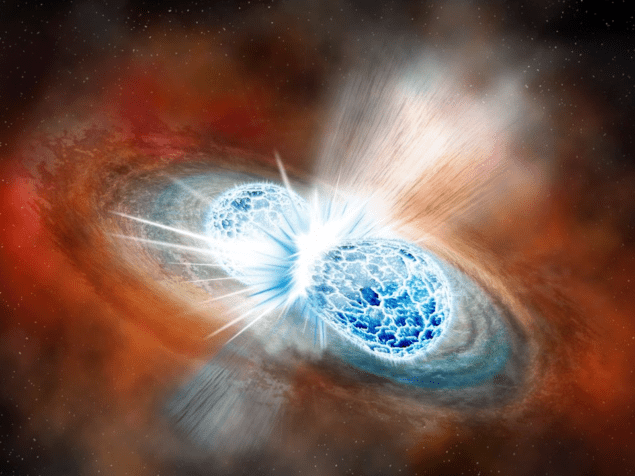
A jet of charged particles moving at nearly the speed of light smashed its way out of debris left behind in the aftermath of the neutron-star merger that produced the gravitational waves detected by the LIGO–Virgo collaboration on 17 August 2017.
The event, catalogued as GW170817, has been a Rosetta Stone for astronomers because it allowed them for to observe the same event using gravitational waves and electromagnetic radiation ranging from a gamma ray burst (GRB) to a radio afterglow. This was a first for the new and exciting field of multimessenger astronomy.
The collision of two neutron stars is called a kilonova and is thought to produce either a black hole or a ‘hypermassive’ neutron star. Some of the neutron-rich debris forms a shell, or cocoon, around the black hole or neutron star. The rest spirals onto the remnant object, producing a jet of charged particles that blasts out into space at nearly the speed of light.
Glowing cocoon
As the jet slams into the cocoon, it causes it to glow, a phenomenon that astronomers call the afterglow. However, it had been unclear whether the jet is able to penetrate through the cocoon and emerge on the other side.
Astronomers, led by Kunal Mooley at Caltech, set about trying to answer this question by observing the afterglow using the High Sensitivity Array, which consists of ten radio telescopes in the US that make up the Very Long Baseline Array, plus the Very Large Array in New Mexico and the Green Bank Observatory in West Virginia. They found that the afterglow had a delayed onset, taking 150 days to reach its peak brightness, whereas other observed afterglows become visible after just a week or two.
The further off-axis Earth is from the direction of the jet, the fainter the afterglow appears to us. The length of the delay implies that we are seeing the afterglow and the jet from a viewing angle of 20°, and that the jet and afterglow had to be intrinsically highly luminous for us to be able to detect them at that angle.
Faster-than-light
Mooley’s team also found that the radio afterglow associated with GW170817 exhibited superluminal – that is, apparent faster-than-light – motion between 75 and 230 days after the kilonova. Superluminal motion is an illusion caused by a very narrow jet – in this case calculated to be just 5° wide – travelling at just less than the speed of light towards us.
These measurements allowed Mooley’s team to gain a better understanding of GW170817. The detection of gravitational waves indicated that it was a binary neutron star merger, and the superluminal motion showed that the jet was able to break through the cocoon.
“By putting this information together, we now have strong observational evidence that binary neutron star mergers produce successful jets,” Mooley tells Physics World.
“This is arguably the best estimate of a GRB jet that we have ever had,” says Ore Gottlieb of Tel Aviv University, who is a co-author with Mooley on a paper describing the findings in Nature.
Lucky find
The surprise has been in finding how narrow the opening angle of the jet, and our viewing angle of the jet and afterglow, were. Had the viewing angle been 30 degrees rather than 20 degrees, says Gottlieb, “we would have missed it.”

Astrophysicists pin down jet from merging neutron stars
They estimate that maybe just one in every 1000 short GRBs with these narrow, highly luminous jets is pointed towards Earth. “It’s plausible that they are much more common in the universe,” says Gottlieb.
Nial Tanvir, who is an astronomer at the University of Leicester, and who was not involved in this research, describes the findings as a “nice result” for answering the question of whether relativistic jets produced by neutron star mergers can break-out from their cocoons.
“It does seem consistent with the long-held idea that many – or maybe all – neutron star mergers produce these very fast-moving jets, which if observed from a vantage point close to the jet axis, will look like a bright, short-duration gamma-ray burst,” he says.



